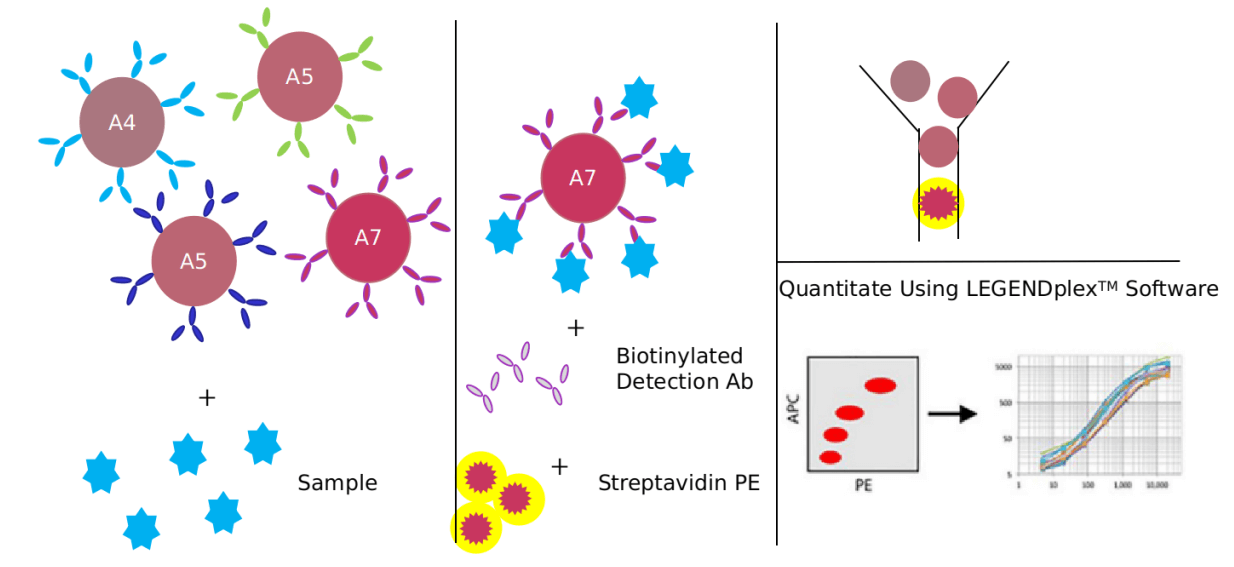APC/C signaling pathway
Based on Luminex technology platform, Creative Proteomics provides analysis services for key targets of APC/C signaling pathway.
The anaphase-promoting complex/cyclosome APC/C is an E3 ubiquitin ligase that targets specific substrates for degradation by the 26S proteasome. APC/C activity depends on two cofactors, namely Cdc20 (cell division cycle 20) and Cdh1, which select the appropriate targets for ubiquitination. It is well established that APC/C is a target of the SAC (spindle assembly checkpoint) during mitosis and has critical roles in controlling the protein levels of major regulators of mitosis and DNA replication. In addition, recent studies have suggested new cell-cycle-independent functions of APC/C in non-mitotic cells and specifically in neuronal structure and function. Given the relevant functions of APC/C in cell proliferation and neuronal physiology, modulating APC/C activity may have beneficial effects in the clinic.
 APC/C is a large multi-subunit complex that promotes the metaphase-to-anaphase progression and G1 arrest by targeting different substrates for ubiquitination and proteasome-mediated destruction. The APC/C contains at least 13 subunits, in which APC10 isinvolved in recognizing and recruiting substrates . The APC/C is evolutionarily conserved, as different APC/C subunits from distinct species are able to complement the corresponding yeast mutants. The APC/C, like other E3 ubiquitin ligasesof the RING family, serves as a binding platform that bringstogether a specific substrate and an E2 coenzyme, resulting inpoly ubiquitination and degradation of the substrate by the 26Sproteasome . Because most APC/C subunits are encode anaphascd bysingle genes,mutants are embryo and/or gametic lethal in bothplants and animals.
APC/C is a large multi-subunit complex that promotes the metaphase-to-anaphase progression and G1 arrest by targeting different substrates for ubiquitination and proteasome-mediated destruction. The APC/C contains at least 13 subunits, in which APC10 isinvolved in recognizing and recruiting substrates . The APC/C is evolutionarily conserved, as different APC/C subunits from distinct species are able to complement the corresponding yeast mutants. The APC/C, like other E3 ubiquitin ligasesof the RING family, serves as a binding platform that bringstogether a specific substrate and an E2 coenzyme, resulting inpoly ubiquitination and degradation of the substrate by the 26Sproteasome . Because most APC/C subunits are encode anaphascd bysingle genes,mutants are embryo and/or gametic lethal in bothplants and animals.
The APC/C promotes degradation of more than a 100 substratesin a specific motif-dependent manner. Typically, substrates ofAPCC contain at least one of three motifs: the destruction box, the KEN box, or the ABBA motif. Interestingly, besides the well-known cell cycle regulation-related proteins targeted by APC/C, several epigenetic regulatorsare substrates of APC/C in animals. For example, Dnmti (DNAmethyltransferase) and G9a (H3K9 methyltransferase) were targeted by APC/C in response to DNA damage, while MIWI (the mouse homolog of Argonaute) and HIWI (the humanhomolog of Argonaute) were targeted by APC/C during malegermline development. These studies provided novel insights intothe function of APC/C, and connect two important regulatory ac-tivities: protein degradation and epigenetic regulation. However, although APC/C degrades DRB4, a double-stranded RNA-binding protein acting in small RNA-mediated gene silencing in plants, the biological importance of APC/C-involved epigenetic regulationin plants was unexplored.
Our detectable targets:
| p53 | BID | APs | tBID | SODD | Bad |
| IPS-1 | ISGF3 | MSK2 | PI3K | TBK1 | Vav |
| BAK | Bax | PIDD | MYD88 | Rac1 | TLR4 |
| Histone-H3 | IRF5 | MEK3 | p38MAPK | SH2 | TRAF6 |
| Bcl-xl | RIP1 | TRAF-2 | FADD | APAF-1 | BID |
| IKK-α | IRS1 | MEK6 | p50 | SLP76 | TRAM |
| FADD | IRF7 | Mda-5 | NFκB | RIG-1 | TRAF3 |
| IKK-β | IRS2 | MSK1 | p65 | Tak1 | TRIF |
| GAS | IRF9 | MEKK1 | p38 | RIP1 | TRAF5 |
| IRAK1 | ISRE | mTOR | PKR | TLR3 |
Technology platform:
We provide Luminex technology for APC/C signaling pathway analysis.
Luminex technology is a multifunctional liquid phase analysis platform developed on the basis of colored microspheres, laser technology, applied fluidics and high-speed digital signal processing technology. The core is to encode polypropylene microspheres or magnetic microspheres with fluorescent dyes. By adjusting the different ratios of the two fluorescent dyes, up to 100 microspheres with different fluorescence spectra can be obtained. Antigen-antibody, enzyme-substrate, ligand-receptor binding reactions and nucleic acid hybridization reactions are performed on microspheres with different fluorescence encoding. Qualitative and quantitative analysis by laser detection of microsphere coding and reporter fluorescence separately.
The anaphase-promoting complex/cyclosome is an E3 ubiquitin ligase. APC/C is widely used in cell proliferation, neuron physiology and clinical medicine.
In addition to Luminex Multiplex Assay, Enzyme-linked immunosorbent assay (ELISA), Flow cytometry (FACS analysis) technology can also be provided to meet other customer needs.
Advantages of APC/C signaling pathway detection:
- Good repeatability: The Luminex detection platform directly reads the fluorescence value, which is more stable and sensitive: 100 microspheres of each type are detected, and the median value is taken as the result, which is equivalent to 100 repeated detections for each sample.
- Low cost: Simultaneous detection of multiple indicators of a sample can save time, samples, reduce detection costs, and improve analysis efficiency.
- High-throughput and high-speed: Each microsphere is used as a separate test body, which can perform a large number of biological tests at the same time. It only needs 10~201 samples to test up to 100 indicators at a time, and the fastest can reach 10,000 tests /hour.

Application of our service:
- To study the regulation mechanism of APC/C signal pathway in disease
- To study the effect of each virus on APC/C signaling pathway
- To study the effects of drugs or therapies on APC/C signaling pathways
Creative Proteomics has developed a signal pathway target detection platform. We are not limited to providing APC/C signal path detection services, but can also provide other signal path detection services. If you want to detect other targets, please contact us and we will customize the service for you. Look forward to working with you.
References:
- Nagy O, et al. lemmingA encodes the Apc11 subunit of the APCC in Drosophila melanogaster that forms a ternary complex with the E2-C type ubiquitin conjugatingenzyme, vihar and Morula/Apc2.Cen Div, 2019, 7: 9.
- Wang Y, et al. The Arabidopsis APC4 subunit of the anaphase-promoting complex/cyclosome (APC/C is critical for both female gametogenesis and embryo-genesis. Plant J, 2020, 69: 227-240.



